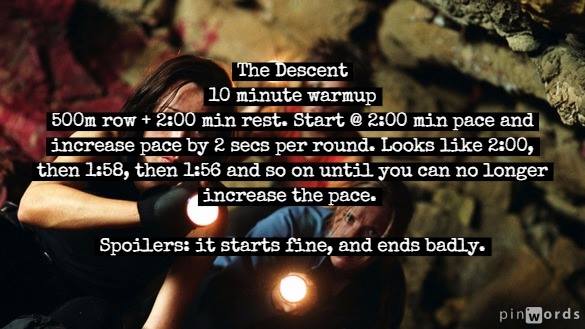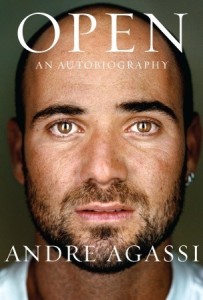]]>
Last year I set my gym-sights on (and barely managed) a 7-minute 2k row, which is considered the minimum acceptable standard among the fine men and women of Gym Jones. This year I’ve been hitting different distances, and managed a borderline-acceptable 10k time (39:46), and an actually-pretty-decent-for-my-weight 500m PB (1:28.6). I’m currently signed up to Concept 2’s Million-Metre Club, and I’m about twenty percent of the way through. I also talk to my wife, half of the trainers at my gym, a few of the people at work, and a bunch of people on Twitter, about stroke rates and damper settings and pacing strategies and split times, basically all the time.
Like I say, I think about it a lot.
The plus side of this is that I also acquire a lot of rowing workouts: whenever someone sends me a new one, I feel honour-bound to try it out, but trying a slightly new ‘thing’ is more fun than doing a 2k/5k/10k every time you crank up the flywheel. With a decent selection of different distances and times to improve on, there’s always something to beat.
So: here’s a selection. The good thing about rowing, as opposed to running, is that there’s basically no adaptation period needed: you aren’t going to get shinsplints or impact injuries by doing too much, too soon. That said, the pacing strategies suggested here are mostly on the ‘hard’ side of things, so if you’re new to rowing/the gym/exercise, downscale them to something that lets you get a decent amount of metres in without blowing yourself out of the water in the first 60 seconds. Real unpleasantness takes time.
#1 Dean Martin
“I feel sorry for people who don’t drink.’ Dean Martin once said. ‘When they wake up in the morning, that’s as good as they’re going to feel all day.” Well, Deano, I drink: and I like doing this workout first thing in the morning, because – unless you get fired or hit by a car or something – it is definitely the worst thing that will happen to you all day. Thanks to the guys of Gym Jones for this: the stupid name is all me, though.
- Row 150m in 30 seconds.
- ‘Rest’ for 90 seconds, but do 10 press-ups and 5 goblet squats (I’d suggest a 24kg dumbbell) during the rest.
- Row 151m in 30 seconds. Rest/pressup/squat again, then row 152m, and so on…until you can’t get the required metres.
The ‘strict’ version of this requires that you just do more metres in each interval, which takes concentration and gets bad quickly if you accidentally hit a 156 early thanks to overzealous pulling. If you’re unused to pacing, just aim to hit the required, and gut it out through at least 15 rounds – if you’re very light or deconditioned, start at 140.
#2 Tabatas
Most people, as previously discussed, get Tabatas completely wrong: doing 20 seconds on, 10 seconds off, for 8 rounds, is not a Tabata, however much you might wish it was. However, they work pretty well in any format where you can thrash yourself to death for 20 seconds and then barely recover. Advantage: rowing.
- Row all-out for 20 seconds.
- ‘Rest’ for 10 seconds.
- Repeat 8 times.
There are two ways to do this: either ‘pace’ it by aiming for a minimum distance per interval (100m is sensible), or just go all-out, every single time. They’re both pretty bad.
#3 The Descent
This comes via the excellent George Mayhew, who is almost definitely a better rower than me. I’ve called it The Descent because, much like the 2005 film, it starts out pleasantly enough, gets very nasty surprisingly quickly and ends in absolute horror. Here goes:
- Row 500m in 2:00m
- Rest for 2 minutes.
- Row 500m in 1:58. Rest 2 min. Keep going, dropping by 2 seconds each interval: 1:56, 1:54…until you can’t make the cutoff. Getting into the 1:40s is a good target – the round of 1:34 is impressive stuff.
#4 The Descent 2
Michael Blevins suggested this one: it’s very much like The Descent, except that it turns bad faster and leaves you more broken.
- Row 500m in 2:00m
- ‘Rest’ for 2 minutes – including 5 pressups.
- Row 500m in 1:58. Rest 2 min, including 10 pressups.
- Keep going, dropping by 2 seconds each interval: 1:56 + 15 pressups, 1:54 + 20 pressups…until you can’t make the cutoff. If you make it to round 7, you’ll have done 105 pressups. Keep going.
This is also a good test of balance: if you’re struggling to finish the pressups before the rowing gets hard, you probably need to do more pressups – and vice versa.
#5 Death by 500
- Row 500m in under 1:42
- Rest 2 minutes
- Do as many rounds as possible.
#6 The 2K Predictor
‘Here’s the secret,’ says Pieter Vodden, who sent this my way. ‘The average pace you can hold for these intervals will be what you can hang onto for a 2k. Translation: if you want to hit a sub-7 2k, you need to hold a 1:45. It’s no fun.
- Row 500m
- Rest 1 minute
- Repeat 10 times
#7 Stairway To Heaven
- 1: Row 250M (3 min. rest);
- 2: Row 500M (3 min rests);
- 3: Row 750M (3 min rest);
- 4: Row 1000M (3 min rest);
- 5: Row 1250M (3 min rest);
- 6: Row 1000M (3 min rest);
- 7: Row 750M (3 min rest);
- 8: Row 500M (3 min rests);
- 9: Row 250M (3 min. rest);
- Do it all at your target 2k pace.
#8 The Count
If you want a nice long session that’s not boring and forces you concentrate on pacing, this is the answer. ‘This is a proper rowing workout,’ says George. ‘By which I mean: one by those who actually row in a boat.’ If it’s good enough for them…
10 min row to warm up
Then:
6000m row completed in 500m continuous blocks. Pacing is done by strokes per minute (s/m). Start @ 18s/m for 1st 500m. Then increase pace by 2s/m every 500m to 28s/m, then go back down to 18s/m. Last 500 is done @ 20s/m. Pace stays between 2:00 and 1:50.
0-500m @ 18s/m
500m-1000m @ 20s/m
1000m-1500m @ 22s/m
1500m-2000m @ 24s/m
2000m-2500m @ 26s/m
2500m-3000m @ 28s/m
3000m-3500m @ 26s/m
3500m-4000m @ 24s/m
4000m-4500m @ 22s/m
4500m-5000m @ 20s/m
5000m-5500m @ 18s/m
5500m-6000m @ 20s/m
Cool down row
‘It’s a different experience rowing to strokes per minute rather than the 500m pace indicator,’ says George. ‘You end up pulling a lot harder. The key is to stick rigidly to the given pace.’
#8 Up To Eleven
- 1000m followed by 3min rest +
- 750m followed by 2:30min rest +
- 500m followed by 2min rest +
- 250m followed by 2min rest +
- 750m finish. Record total row time.
BANG. Add those to your regular rows, and you’ll be hitting new PBs in no time. Hit me up on Twitter: I’ll be happy to congratulate you.
]]>
Assault On Lake Casitas
Brad Alan Lewis
It’s possible you’ve never heard of rower-turned-prolific-author Lewis, but that needs to change. Firstly, he took the hardest of all possible routes to the Olympics – after falling short in the single scull trials and being passed over in selection for the doubles, he did everything from training alone to scrounging his own boat en route to the 1984 finals. Secondly, he’s an incredibly thoughtful, honest writer – it’s fairly tricky to get across the physical and psychological horrors of rowing a legitimate all-out 2k via words on a page, but he somehow manages it. And thirdly, there’s a wealth of training advice here, on everything from sets and reps to psychology and ‘shadow rowing.’ Once you’re done with this one, you’ll want to move onto Wanted: Rowing Coach, and Lido For Time, Lewis’ annotated book of pre-Olympic workouts – they’re both inspiring reading, and the second one even has a recipe for waffles.
It’s true, it’s true
Kurt Angle
Yes, really. You might know Kurt Angle as the star-spangled-singlet-wearing WWE star who once attacked Vince McMahon with a milk cannon – or you may just not know him at all – but pre-professional wrestling, Angle was a legitimate monster on the mat, ultimately winning Olympic gold with two fractured cervical vertebrae and a pair of herniated discs in his neck. His book’s worth reading for the chapter on his Olympic training alone, including his leg workouts ‘I’d take 80lb dumbbells, squat down and jump up as high as I could, 50 to 100 times,’ his training under Dan Gable – he once wrestled one ‘match’ that lasted 70 minutes – and the mornings he’d do hill sprints carrying his manager. Yes, he occasionally comes across as arrogant – especially in the second half of the book – but the way he applied the same Olympian work ethic to succeeding in the WWE is an object lesson in competence spanning fields. He also trained at Foxcatcher with Dave and Mark Schultz, and his thoughts on them are worth your time.
Open
Andre Agassi
Fine: Agassi isn’t really most famous for his Olympic gold, even though he took it as part of the impossibly-rare career ‘golden slam’ – winning it alongside all four major opens, a feat which only Nadal has matched among the men’s field. But you should read his book anyway, because it’s a terrifying account of just what it takes to succeed at that level, from hitting 1,000 balls every morning under the watchful eye of an obsessive father, via the ultra-competitive environment of a teen tennis academy, to the reinvention via strength and conditioning that it takes to succeed on the main tour. Even if tennis does nothing for you, the pain and perseverance on display in this book ought to give you a newfound respect for its athletes – and the combination of strategy, psychology, nutrition, conditioning and sheer, awful repetition it takes to succeed might give you pause next time you see what you think is an overpaid athlete throwing a strop. Oh, and there’s a lesson in here for Black Swan fans and pushy, too: all of Agassi’s siblings underwent similar training, and only Agassi made it – after nearly dropping out of tennis. Success is never guaranteed.
]]>
Examples? Sure thing. In mythology, for instance, the Phoenix is robust – it dies, but comes back unchanged. The Hydra is Antifragile – chop off its head, and it grows two more. Become an entrepreneur instead of working for a large, unwieldy company, Taleb says, and you’re like the Hydra – more able to adapt and change when bad things happen. Chase after status, and you’re at the mercy of trends – develop social capital, and you’ll be well-prepared for most problems. When chaos comes, you’ll adapt better than most, and end up ahead.
It’s sensible thinking, and the book’s worth reading. But how does this relate to your training plan?
Taleb does make some suggestions about fitness in his book – he does some powerlifting, and suggests switching between diets on a near-daily basis – but, with respect to him, it’s not really his area of expertise. And it’s true to say that the point of any sort of training plan is to take advantage of the human body’s natural antifragility, since adapting to the stress of lifting weights or running is how your body gets stronger. But can you go further? Yes, you can.
Here’s the thing: it can actually be quite difficult to plan to introduce some chaos into your workout, but by embracing it when it happens you can better prepare yourself for the randomness of life: now and in the future. Unless you’re a professional sportsperson or you’re training for a competition, you want your training and nutrition to be sustainable pretty much forever – which means making it adaptable without making it into a completely random mess. Here’s how you do that.
Introduce disorder
Really, this means having a workout that will force your body to adapt. When you start training, this is simple: that’s why P90X and Crossfit get such miraculous results in the early going. As you get fitter, it’s harder to introduce the right kind of stress to your body – which means keeping track of your gym numbers, and aiming to improve them.
Think upside vs downside
Taleb’s books are all about this. If your investment strategy makes a steady stream of income but can see you lose all your money in an unpredictable (but likely) random event, that’s a lot of downside. If it minimises risk while giving you the chance of making a fortune, that’s a lot of upside. Exercise is the same: every move or training protocol you can pick has risks and rewards. If rowing and sprinting will both get you to the bodyfat percentage you want, is it worth risking a blown hamstring with the latter? If snatches will make you 10% more explosive than a similar frequency of trap-bar jumps but could wreck your shoulders, which do you do? For non-athletes, the answer is almost always to pick the exercise that will get the most results with the least possible risk of injury.
Throw things out
The Romans, Taleb notes, called this via negativa. Yes, having a cable-cross is nice, but do you really need it when you can get similar results with a set of go-anywhere gymnastics rings? Strip out the unnecessary from your training plan and you’ll have more time to concentrate on the important. If in doubt, consider Gym Jones’ classic SMMF – 1,000 lunges, or 100 handstand pressups, done over an hour or so. Simple and nasty.
Add to your workout ‘quiver’
If you’re lost without the gym’s only E-Z bar, workout time is always going to be frustrating. Conversely, if you can train with whatever’s to hand then you’ll never have to wait for kit – and your body will benefit from the variety. Bare minimum, you should aim to learn, by heart, a workout you can do with no kit at all, then ones that use a single piece of kit: a pull up bar, a barbell, some dumbbells, and a TRX…and expand from there. Nobody likes the guy curling in the squat rack, but if you have six different leg workouts in the clip, you won’t have to deal with him.
Train through the day
Ignore the false dichotomy between ‘gym time’ and the rest of your day – activity is activity. Pavel calls it Greasing The Groove, while anyone preparing for the SEAL’s notorious Hell Week knows the value of doing dozens of pressups, spaced out through the day. Make doing a set of pull ups, pressups or squats during downtime instinctive, and you’ll increase your work capacity with barely any effort.
Learn to ‘fast’
Eating six small meals a day works great – right up until life makes it impossible. Learn when your body does (and doesn’t) need fuel, and a day without tupperware won’t send you into a panic. The rule of thumb? More carbs around training sessions, less on rest days, and no meltdowns if you have to skip a meal entirely. Part of the benefit of fasting is that you’ll learn that it’s okay to be a bit hungry. A green tea will be fine. Maybe have an apple.
Learn to cook
Obvious, but underrated. Crucially, learn to cook meals that use leftovers, different cuts of meat, and things that are available in your local 24-hour garage – no cardamom pods required. Learning six ways to make eggs and leftovers palatable is more important than perfecting a coq au vin, and easier. Start here.
Plan, but be adaptable
This is what it all comes down to. Funnily enough, most athletes’ training plans are very ‘fragile’ – if your plan relies on six training days a week, a tailored nutrition programme and 9 hours of uninterrupted sleep and you aren’t a paid professional athlete, you are probably going to fuck up somewhere. Strip it back to the basics: three hard sessions a week, more walks to the shops and pressups whenever you’re at a loose end, your workout plan should be near-bulletproof.
]]>


